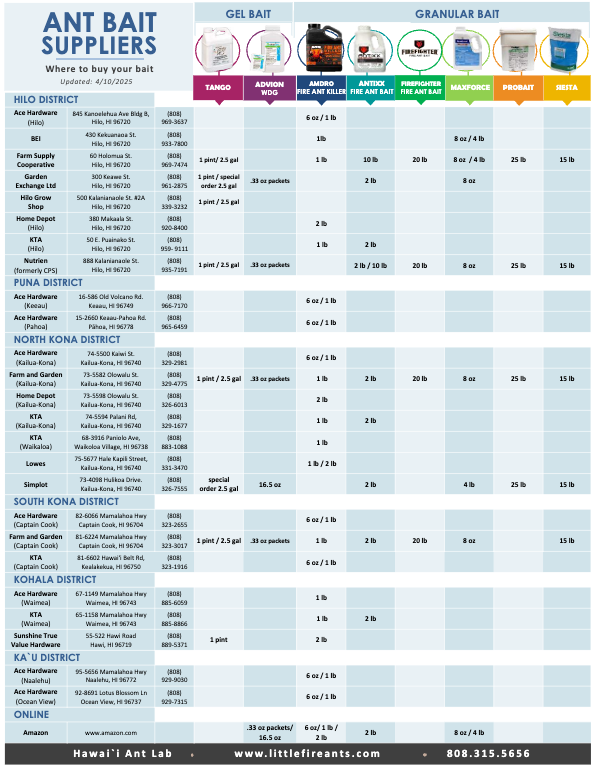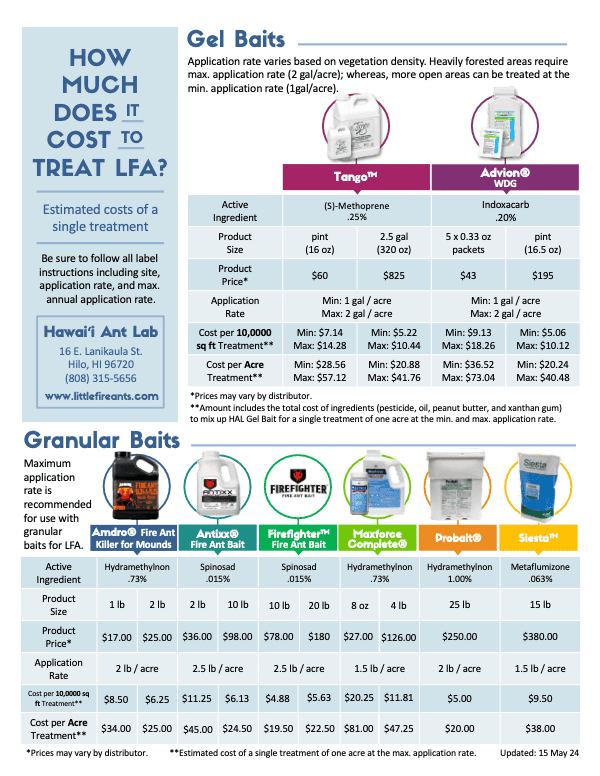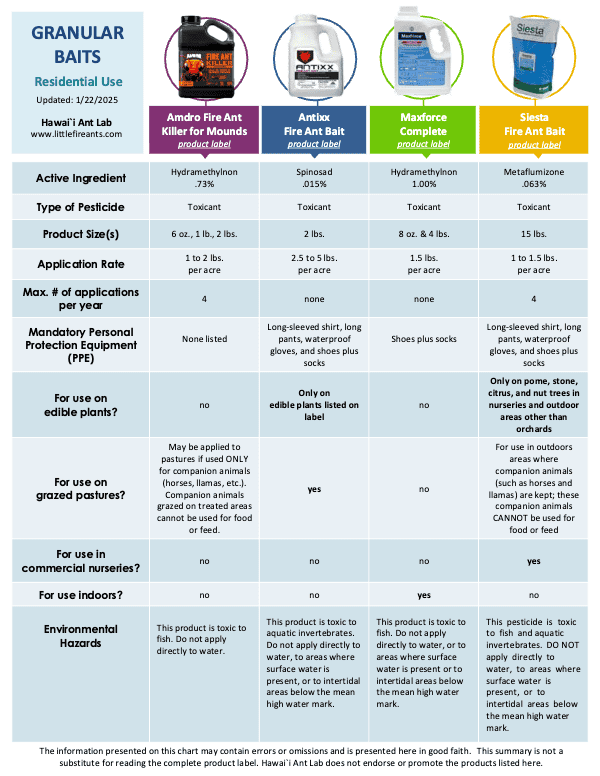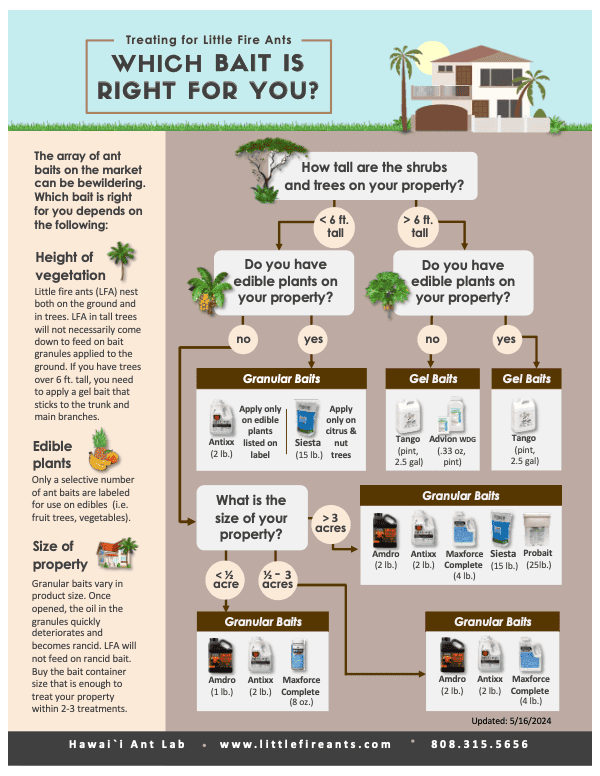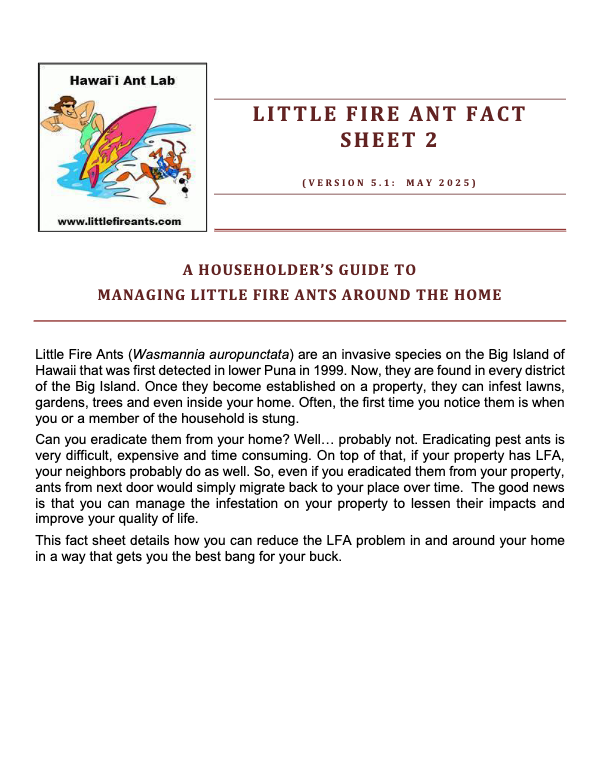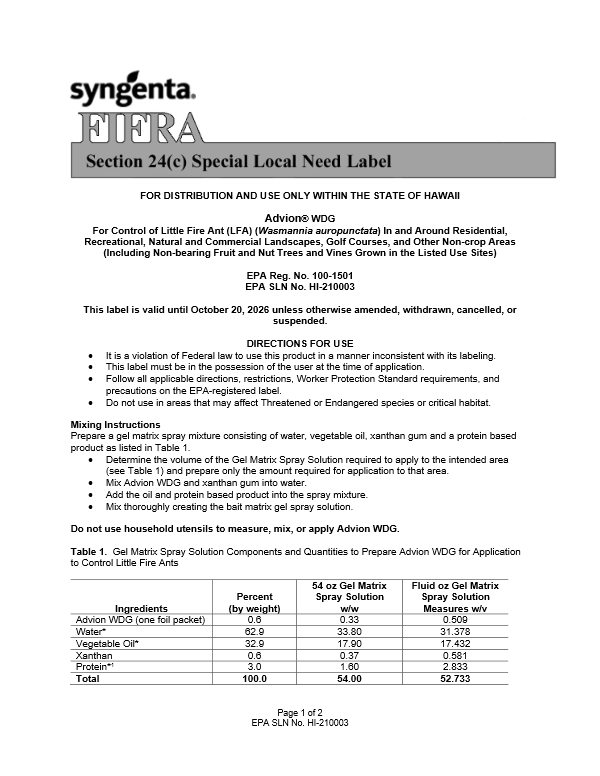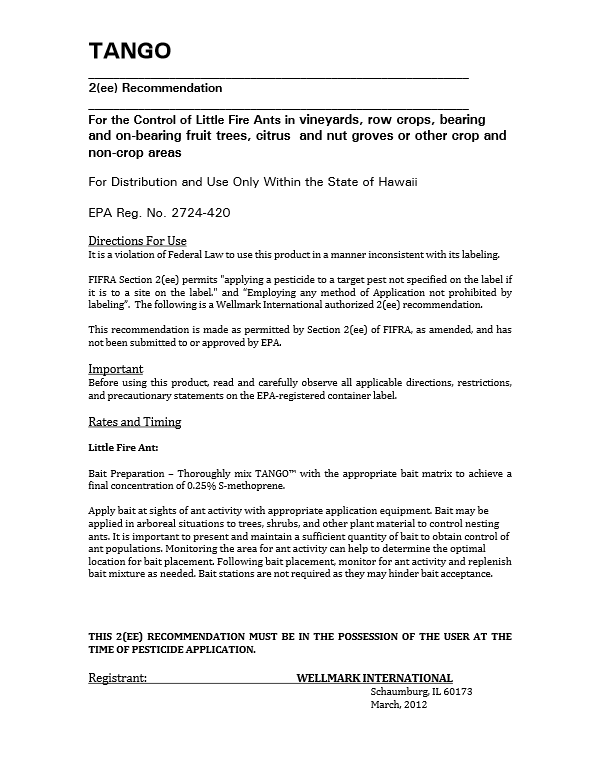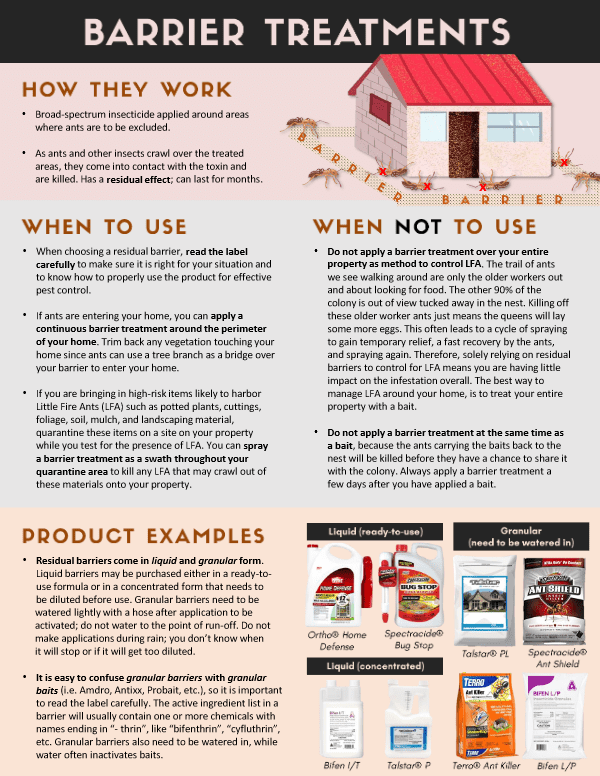How to Treat Little Fire Ants Around Your Home
Once Little Fire Ants (LFA) become established on your property, they can infest your lawn, garden, trees and even inside your home.
Can you eradicate them from your property? Well… probably not. Eradicating pest ants is very difficult, expensive, and time consuming. On top of that, if your property has LFA, your neighbors probably do as well. So, even if you eradicated them from your property, ants from next door would simply migrate back to your place over time.
The good news is that you can manage the infestation on your property to lessen their impacts and improve your quality of life.

Overview
The following guide provides answers to commonly asked questions about treating Little Fire Ants around your home:
- What is the Difference Between Baits, Barriers, and Contact Sprays?
- How Do I Treat For Little Fire Ants?
- What Are the Basics of Applying Bait?
- Which Bait is Right for Me?
- Which Bait Products Are Recommended?
- Which Products Are NOT Recommended?
By the time you reach the end of the guide, you should have an understanding of the currently accepted best practices for controlling LFA around your home, which baits are available and most effective, and how best to apply them for long-term results. If you have any further questions, don’t hesitate to contact us.
For a PDF version of this guide, see A Householder’s Guide to Managing Little Fire Ants Around the Home.
What is the Difference Between Baits, Barriers, & Contact Sprays?
The array of pesticides on the shelf at your local garden center or hardware store can be mystifying. There are dozens of different proprietary products available, and it can be very difficult to know which is the right one for your situation. Some are liquids, some are granules; they can be in small bottles or huge bags, in ready-to-use spray bottles or concentrates… So, which one do you buy?
Pesticides for Little Fire Ant (LFA) control can be divided into three main types: baits, barrier treatments, and contact sprays. Each of these work differently and it’s important to know which is which.
Ant Baits
Baits are an attractive food laced either with a toxin (usually a very small amount) or an insect growth regulator (IGR). Most baits for control of Little Fire Ants (LFA) come in a granular form made from corn grits to make them easier to spread. LFA feed on the bait, return to the nest leaving a trail for other worker ants to follow, and then regurgitate the bait to share with the rest of the colony.
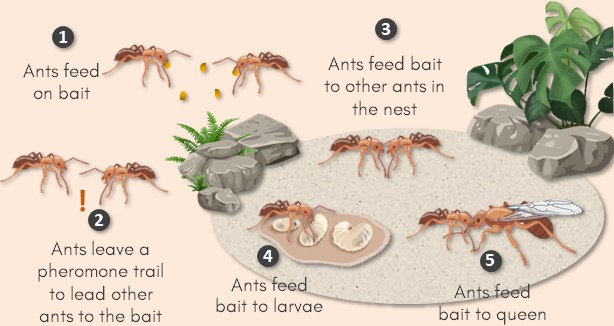
Two types of ant baits:
- Toxicant Baits – Made with a very small amount of slow-acting toxin so ants have time to make their way back to the nest and share the bait with other members of the colony before they are killed within 72 hours. Toxic bait products include Amdro®, Antixx®, Probait®, Siesta™, Maxforce Complete®, Advion® WDG.
- Insect Growth Regulator Baits – Work by preventing ant young from developing into adults, but have no effect on adult worker ants. It also prevents or slows down egg production by the queen. Ant colonies baited with an IGR slowly die out over a period of months as worker ants die from natural causes and are not replaced by new workers. IGR products include Tango™.
Baits are the recommended first-line treatment because they are very effective and also minimize the use of pesticides.
Barrier Treatments
Barrier treatments are insecticides that come in liquid or granular form and are sprayed or sprinkled around areas where ants are to be excluded. As ants and other insects crawl over the treated areas, they come into contact with the toxin and are killed. Barrier treatments usually have a residual activity and can provide protection for months.
Granular barrier treatments can be spread using a simple seed spreader, just like baits. However, it is good practice to have 2 spreaders – one for use with baits and the other for the barrier treatment (mark each one with a marker pen so you know which is which). If you use the same spreader for both jobs, it is possible you might taint the baits with traces of the barrier granules. The ants could be repelled by the smell of the barrier granules and not feed on the bait. The chemicals in granular barrier treatments need to be wetted to become active. This helps the binding process needed for the chemicals to work.
It is easy to confuse granular barriers with granular baits, so it is important to read the label carefully. Many granular barriers contain synthetic pyrethroids. The active ingredient list will usually contain one or more chemicals with names ending in “- thrin”, like “bifenthrin”, “cyfluthrin”, etc. Granular barriers also need to be watered before they are activated, while water often inactivates baits.
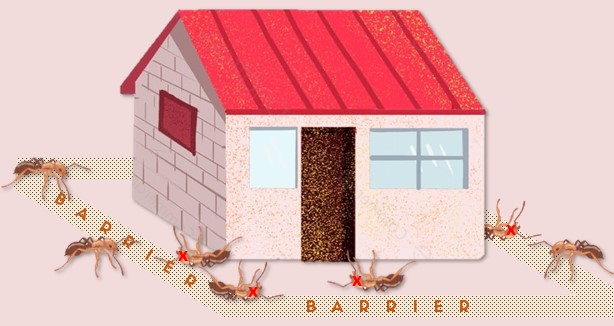
Never apply a barrier treatment at the same time as bait, because the ants carrying the baits back to the nest will be killed before they have a chance to share it with the colony. Always apply the barrier treatment a few days after you have applied the bait.
Examples of barrier products include Talstar® PL, Ortho® Home Defense, Spectracide® Bug Stop® Home Barrier, Bifen IT.
Contact Sprays
Contacts sprays are insecticides often sold in pressurized aerosol cans. Most insecticidal sprays are general insecticides which will kill other insects as well as ants. It works at the point of contact with no residual effect, killing only the insects that you see and spray. As a result, it is not very useful for controlling Little Fire Ants, except for instances where you wish to remove individual ants from a particular location for a short period of time.
There is a wide variety of organic and conventional products available in concentrates and ready-to-use formulations. Some may be used on food plants, though they are more effective as spot treatments or for small areas. When choosing an insecticidal spray, read the label carefully to make sure it is right for your situation and to know how to properly use the product for effective pest control.
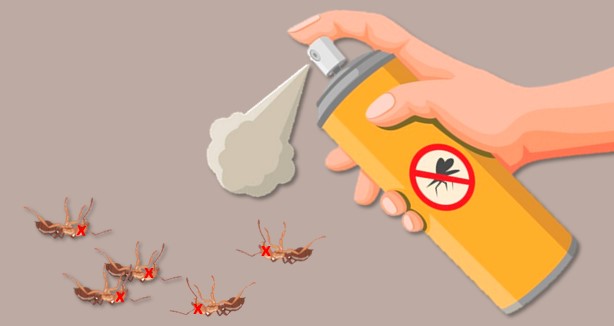
Examples of contact sprays include Orange Guard®, Sevin® Ready-To-Use Bug Killer, Defender™ Pyrethrum Insect Spray, Spectracide® Malathion Insect Spray.
Video: How to choose the right product
Learn the difference between barrier/residual and bait products and how to choose the right LFA control product for treating your property.
How Do I Treat For Little Fire Ants?
First, apply an ant bait
Often, our first reaction on seeing Little Fire Ants (LFA) is to grab a can of insect spray and let them have it. But using contact sprays is rarely successful for controlling LFA. The trail of ants we see are only the older workers out and about looking for food. The other 90% of the colony is out of view tucked away in the nest. Killing off these older worker ants just means the queens will lay some more eggs. This often leads to a cycle of spraying to gain temporary relief, a fast recovery by the ants, and spraying again. Therefore, solely relying on contact sprays to control for LFA means you are having little impact on the infestation overall.
Decades ago, scientists researching better ways of controlling ants found that using a bait was more effective. Baits are made from a food that is attractive to ants and laced with a small quantity of slow-acting toxin. Worker ants feed on the bait, and when they return to the nest, regurgitate some to share with other workers and the queen. This approach has proven to be more effective than toxic sprays and has an added benefit of minimizing the use of pesticides.
The best way to manage LFA around your home, is to treat your entire property with a bait every 4-6 weeks for at least a one year period. After a year, survey your property and identify the “hot spots” where LFA are still present. Continue treating the “hot spots” and your property’s border to prevent LFA migrating back in from your neighbors’ properties.
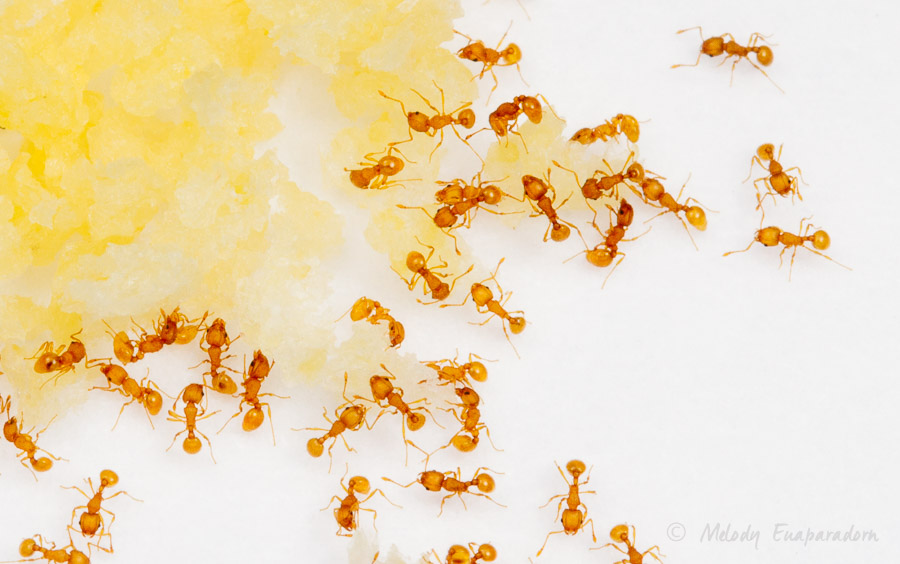
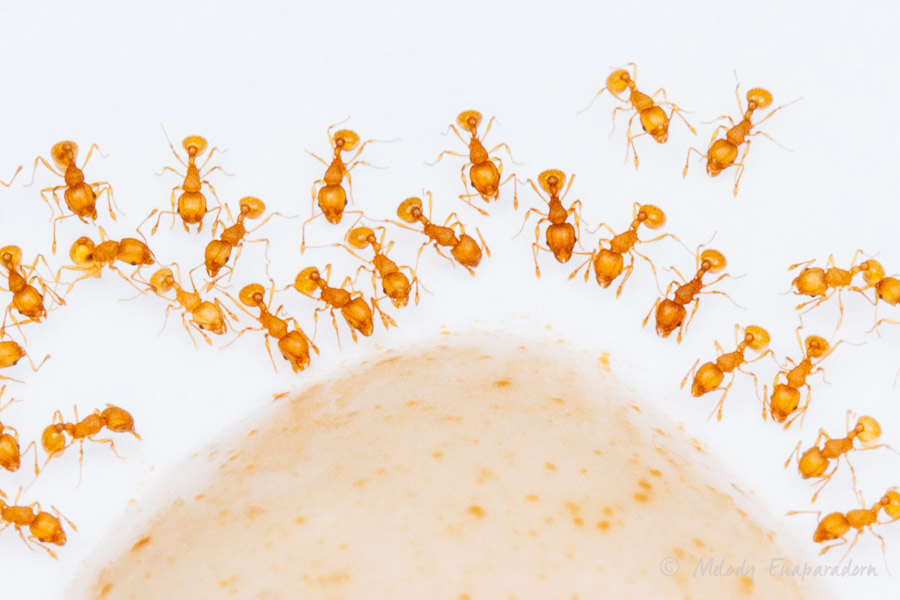
Second, apply a barrier treatment (if needed)
If LFA are entering your home, you can also choose to apply a barrier treatment along the perimeter of your house structure. As ants crawl over the treated areas, they come into contact with the toxin and are killed. Barrier treatments usually have a residual activity and can provide protection for months. LFA prefer living outside and are only wandering around your home looking for food. So, it makes more sense to deal with the problem outside the house rather than spreading insecticides in your home.
If you will be using this dual approach of baiting and applying a barrier treatment, it is important to use them properly. Small differences to your application method can lead to big differences in results. First, NEVER apply a bait and a barrier treatment at the same time. Why?… Well, baits work when ants bring them back to the colony and share them with all the workers (and also to tell the others where to get more bait). If a worker ant is carrying some bait back to the nest and crosses over a barrier treatment, she will die before being able to get back to the colony. One treatment will cancel out the other and you will be wasting your hard-earned cash. So, bait first and give the baits enough time to have an effect – a few days is sufficient; then, if you choose, apply barrier treatments. Re-apply barrier treatments as needed (according to the label).
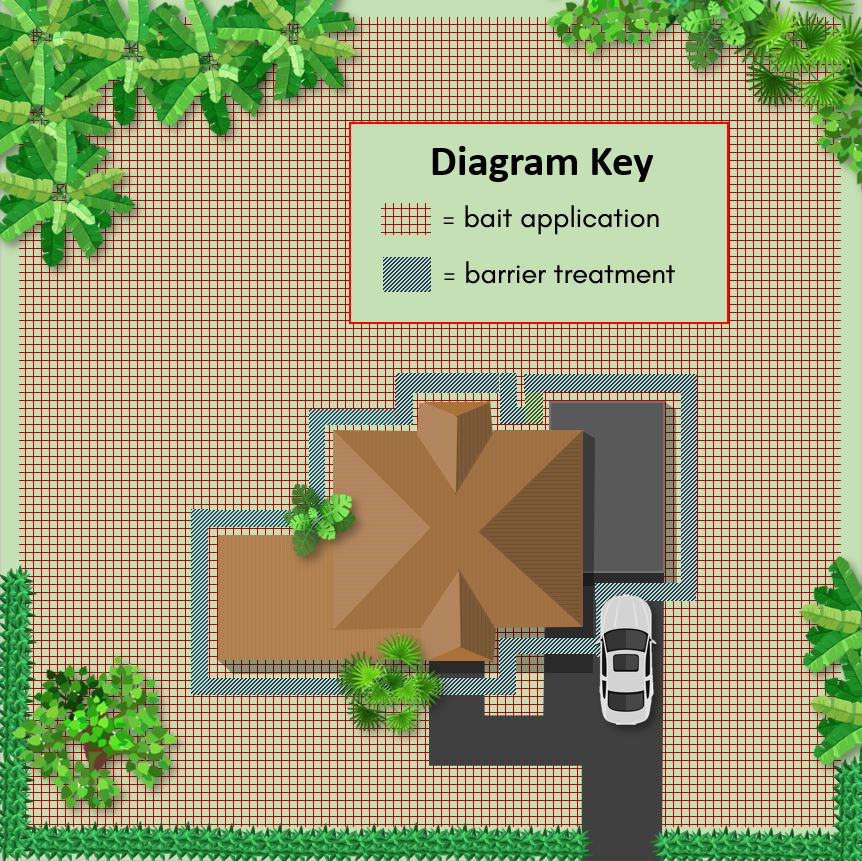
What Are the Basics of Applying Bait?
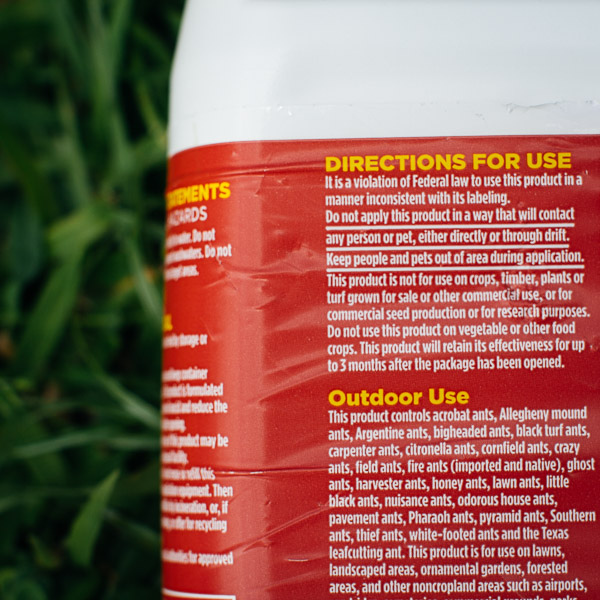
Read the label
Always read the label directions for the product you intend to use. The label is a legal document and specifies what you can and can not do. It will also list any precautions you should take and any personal protective equipment (PPE) you should wear while mixing and applying the product.

Control LFA with baits
The baits most suitable for control of Little Fire Ants all look very similar – small yellow granules around ⅛ inch in size. The granules are actually corn grits which have been infused with vegetable oil and a toxin. They are most easily spread using a small seed spreader.

Do not use old bait
Once the bottle has been opened, the baits will quickly deteriorate and become rancid, so you should use any opened container within 2-3 treatments. Bad bait will not be attractive to ants and they will not feed on it. Most baits come in different pack sizes, so buy the size that is sufficient to treat your property. This way your bait will always be fresh.

Treat in dry weather
Rainfall makes the bait soggy and unattractive to ants. Try to pick a dry day for applying baits. In places where this is difficult, a dry period of around 4 hours after treatment should be sufficient time for ants to find the granules, return to the nest, and then regurgitate the bait to share with the rest of the colony. After a day or so, the baits are no longer effective, even without rainfall.

Treat your entire property
One mistake a lot of people make is to only spread bait in places where they have “seen” ants. It is very important to treat your entire property, because LFA have lots of small nests and often we do not know where they all are. So, walk over the entire property and systematically apply the bait to every section. This is actually quite easy to do if a small seed spreader is used.
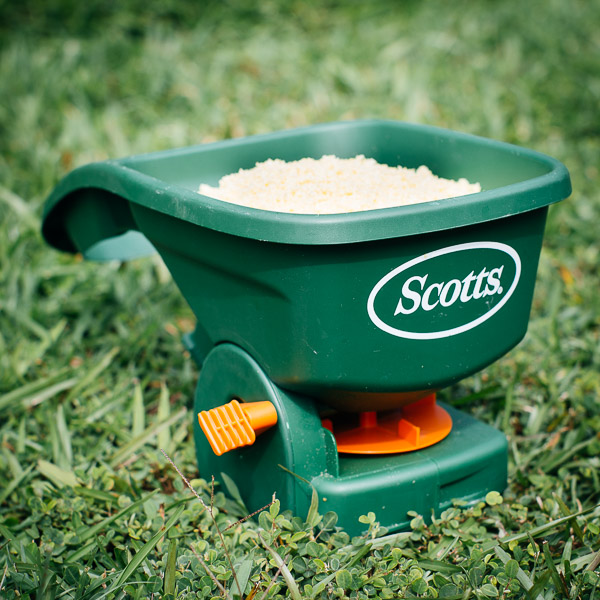
Use a seed spreader
These are available at low cost from hardware and pesticide stores. They feature a hopper for holding the bait, a winding handle that agitates the bait and scatters it over the ground, and an adjustable aperture that is used to calibrate output. These spreaders are also used to scatter seeds and fertilizer.

Do not over apply
With the aperture set at “1” (see above) turn the spreader handle at approximately 1 revolution per step while walking at 2-3 mph. The bait will fling out and create a swath of about 4 yards. Remember, not a whole lot of bait is needed and often it is spread so thinly on the ground, it seems you have not put out enough. Don’t worry – there will be enough bait there.
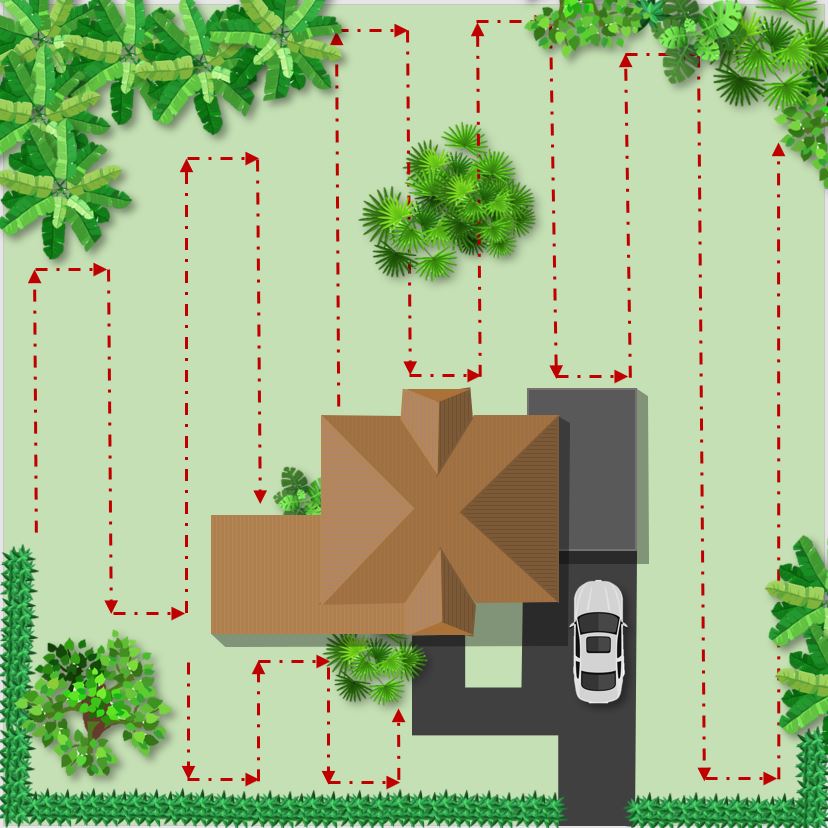
Spread bait systematically
When applying the bait over your property, a series of parallel swathes is recommended. This is accomplished by starting on one corner of your property and walking along the edge, treating 1 yard in from the boundary line. Once you reach the opposite corner, take 2 paces towards the untreated area and return parallel to the original path, working around buildings and other obstacles (see above). Continuing this process, you will be able to systematically cover the entire property in just a few minutes. It is important that all ground is treated including spaces between buildings and corners of gardens.
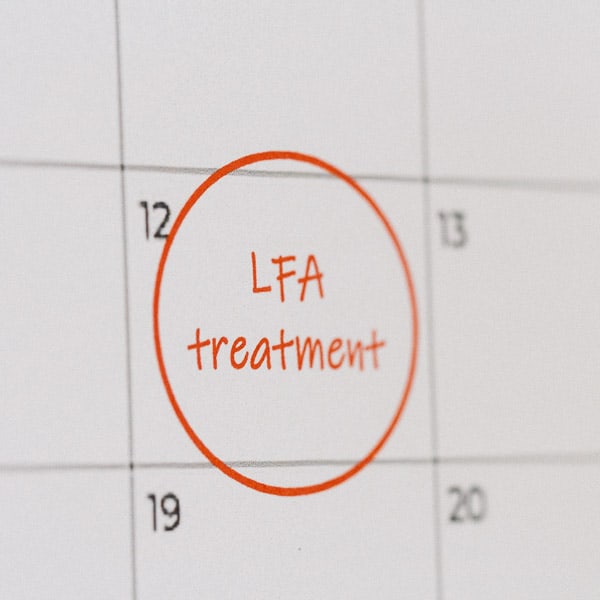
Treat every 4-6 weeks
A common mistake is to either bait again too soon or wait too long between treatments. If you bait too soon, the ants that survived the first round of baiting can remember that those little yellow granules made them sick last time, and will actually avoid taking your baits the next time around. If you wait too long, the LFA population can rebound. Each LFA colony has multiple queens and each queen can produce about 7 eggs a day. Even if some are killed by your first treatment, the remaining queens will increase egg production. LFA can completely recover from a single bait treatment in 8-10 weeks. Mark your treatments on your calendar and do your best to treat every 4-6 weeks.
Video: How to
apply granular bait product
This baiting basics video covers the best practices of applying granular baits and common errors of baiting.
Which Bait is Right for Me?
There are a number of baits available on the market to control Little Fire Ants. Which bait is right for you depends on the following:

Height of your vegetation
To effectively reduce the number of Little Fire Ants (LFA) around your home, you need to apply bait where LFA like to nest – on the ground and in trees. One problem facing the homeowner is that virtually all commercial baits consist of small granules. These are easy to spread on the ground, but can not be applied to vegetation. Ants in the trees will not necessarily come to the ground to forage on the granules. If only the colonies on the ground are treated, neighboring ants living in trees will quickly spread back to the ground. If you have trees over 6 ft. tall, you need to apply Hawaiʻi Ant Lab’s gel bait with Tango™ or Advion® WDG that will stick to the trunk and main branches. Learn more about gel baits in our guide to Mixing HAL Gel Bait for Control of Little Fire Ants.
Whether you have edible plants
If you have fruit trees or vegetable plants on your property, you are limited by which bait products you can use. Many pesticides are not registered for use on food plants. Be sure to read a product’s label carefully to make sure whether it can be applied on edible plants and if your crop or fruit is listed. You can download product labels by going to the Hawaii Pesticide Information Retrieval System. Baits available in Hawaiʻi for the control of LFA that may be used on or near food plants include the following:
- Tango™ – Registered for use on and under any food plants.
- Siesta™ Insecticide Fire Ant Bait – Can be used on stone, pome, citrus and nut trees.
- Antixx® – Has some edible crops on the label; see label for details.
Size of your property
Granular baits vary in product size. Once opened, the oil in the granules quickly deteriorates and becomes rancid. LFA will not feed on rancid bait. Buy the bait container size that is enough to treat your property within 2-3 treatments. Bait recommendations according to property size are as follows:
- < 1/2 acre – Amdro® Kill Fire Ants for Mounds (1 lb), Antixx® (2lb), Maxforce Complete® (8 oz)
- 1/2 acre to 3 acres – Amdro® Kill Fire Ants for Mounds (1 lb), Antixx® (2lb), Maxforce Complete® (4 lb). Probait® (4.5 lb)
- > 3 acres – Amdro® Kill Fire Ants for Mounds (1 lb), Antixx® (2lb), Maxforce Complete® (4 lb), Probait® (4.5 lb), Siesta™ Insecticide Fire Ant Bait (15 lb)
Which Bait Products Are Recommended?
GRANULAR BAITS
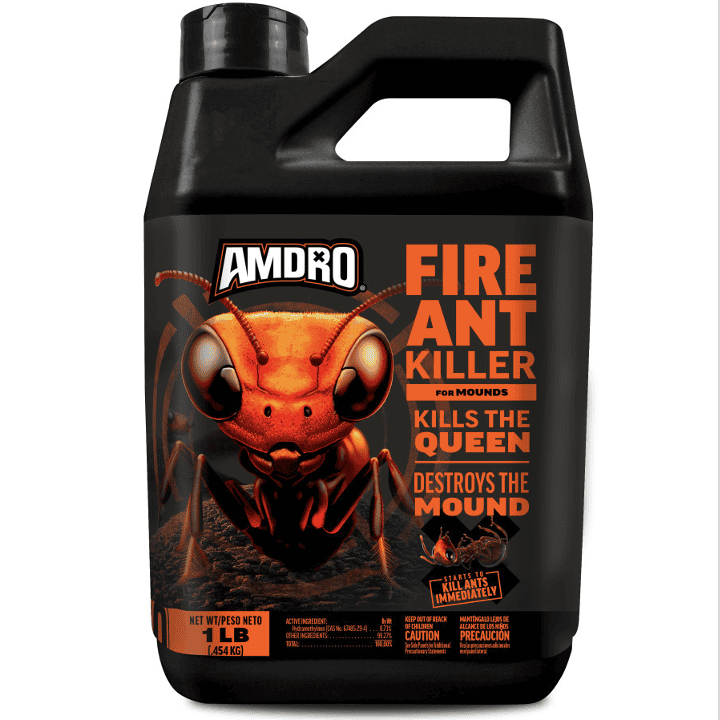
Amdro® Fire Ant Killer for Mounds
Toxicant
Amdro® is sold at most garden centers, hardware stores, and chemical supply companies, under several different names. Only some are effective; be sure to buy Amdro products with only one active ingredient: Hydramethylnon. This product seems to be consistently effective and is very popular. EPA Reg. No. 73342-1-90098
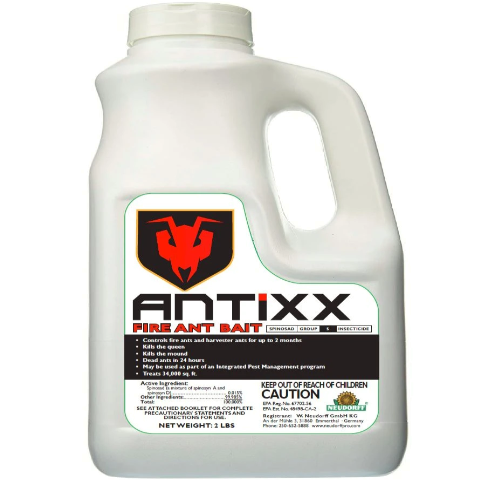
Antixx® Fire Ant Bait
Toxicant
Antixx® is a granular bait recently registered for use in Hawai‘i. It has the active ingredient Spinosad, which is derived from naturally occurring soil bacterium. It is registered for use on some edible crops. Be sure to read the label carefully to make sure your crop or fruit is listed. EPA Reg. No. 67702-56
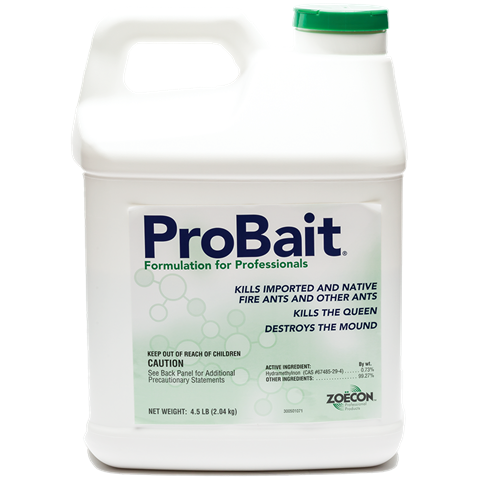
ProBait®
Toxicant
ProBait® is sold at chemical supply companies, and has the same active ingredient as Amdro®. Usually it is sold in larger jugs. This product is also a consistent performer. EPA Reg. No. 73342-1-2724
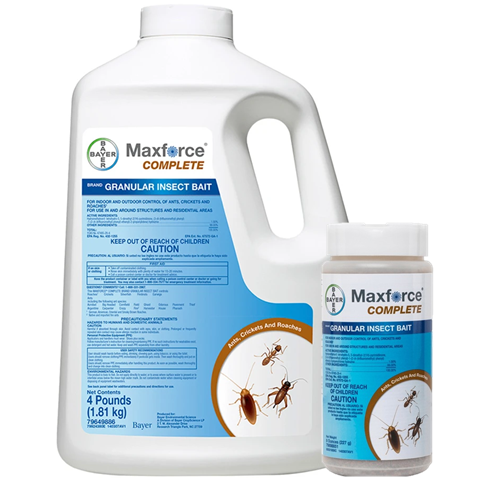
Maxforce Complete®
Toxicant
Maxforce Complete® is sold at chemical supply companies and has a very attractive bait matrix, including a sugar, fat and protein attractant. It is a little more expensive than other products but we have found it to be extremely effective. EPA Reg. No. 432-1255
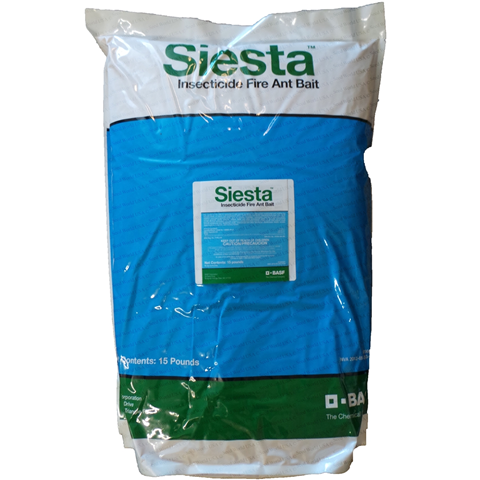
Siesta™ Insecticide Fire Ant Bait
Toxicant
Siesta™ Insecticide Fire Ant Bait is sold at chemical supply companies. It appears to tolerate moisture better than other granular baits. Siesta is only available in a 15 lb bag. Since baits quickly deteriorate after opening and should be used within 2-3 treatments, we recommend Siesta™ to property owners treating 3 acres and over. EPA Reg. No. 7969-232
PRODUCTS FOR GEL BAITS
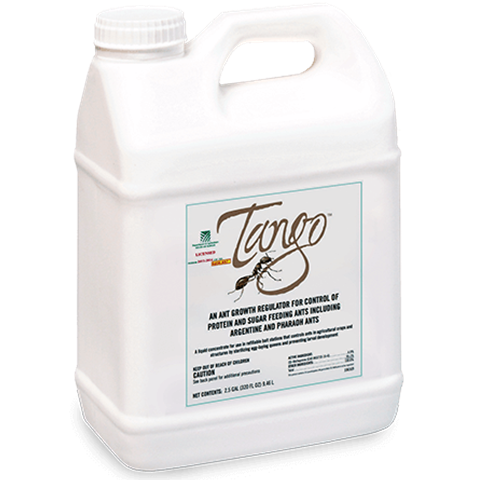
Tango™
Insect Growth Regulator
Tango™ is a concentrate product that contains (S)-methoprene, an insect growth regulator (or IGR). It works by preventing affected insect larvae from completing the pupation process but has no effect on adult worker ants. It also prevents or slows down egg production by the queen. Ant colonies baited with an IGR slowly die out over a period of months as worker ants die from natural causes. Tango™ appears to be very effective and safe, and is registered for use on and under food plants. The manufacturer has issued a 2(ee) recommendation that provides specific instructions for mixing the concentrate with a bait matrix for the treatment of LFA. Please read our guide on Mixing HAL Gel Bait for Control of Little Fire Ants to find out if it is right for you. EPA Reg. No. 2724
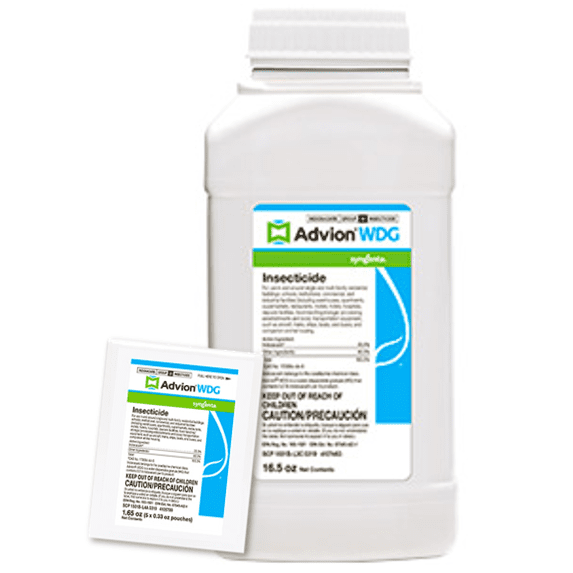
Advion® WDG
Toxicant
Advion® WDG is a water soluble granule containing the active ingredient indoxacarb. The manufacturer of Advion® WDG has applied for and been issued with a “Special Local Need” permit (or SLN) which allows users in Hawai`i to add Advion® WDG to the HAL gel bait for control of Little Fire Ants. Advion® WDG is fast acting and usually dramatic results will be noticed in as little as 2-3 days after treatment. Learn more about Advion® WDG in our guide on Mixing HAL Gel Bait for Control of Little Fire Ants. EPA Reg. No. 100-1501

Provaunt®
Toxicant
The product Provaunt® (EPA Reg. No. 100-1487) has been discontinued and is no longer available for purchase. Other Provaunt® products (i.e. Provaunt® WDG) have not been approved for use in the HAL gel bait. Advion® WDG is the equivalent replacement.
Which Products Are NOT Recommended?
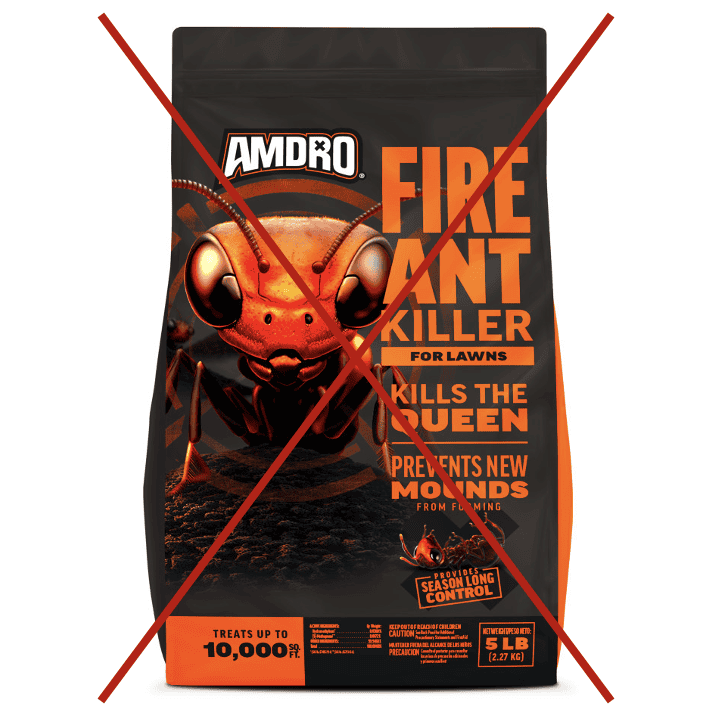
Amdro® Fire Ant Killer for Lawns
Amdro® Fire Ant Killer for Lawns contains two active ingredients, the insect growth regulator methoprene and hydramethylnon, and comes in a black shaker bag. This product is NOT recommended for the control of Little Fire Ants. Half of the granules have hydramethylnon and the other half contain methoprene. The formulation of the methoprene granules is not attractive to LFA. EPA Reg. No. 73342-6-90098

Spectracide® Fire Ant Shield Mound Destroyer
Spectricide® Fire Ant Shield Mound Destroyer is a residual granular pesticide formulated to be sprinkled directly on the nest mounds built by the Red Imported Fire Ant, a species not found in Hawai‘i. Little Fire Ants (LFA) do not build mounded dirt nests. This product is NOT recommended for the control of LFA. EPA Reg. No. 9688-174-8845
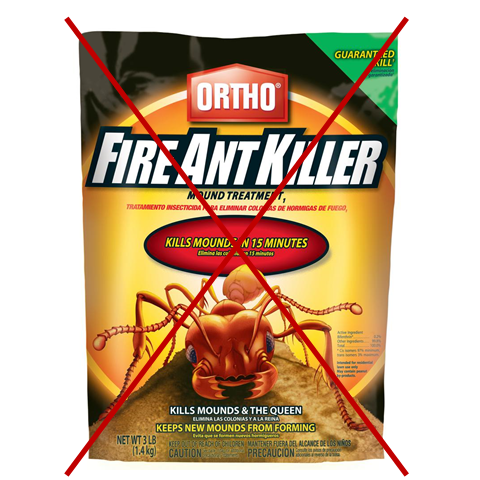
Ortho® Fire Ant Killer Mound Treatment
Ortho® Fire Ant Killer Mound Treatment is a residual granular pesticide formulated to be sprinkled directly on the nest mounds built by the Red Imported Fire Ant, a species not found in Hawai‘i. Little Fire Ants (LFA) do not build mounded dirt nests. This product is NOT recommended for the control of LFA. EPA Reg. No. 239-2738
